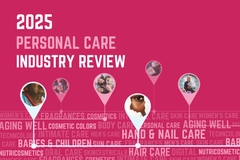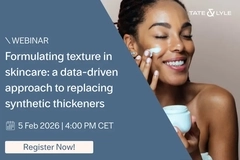The Gen Z Effect: Revieve study finds digital natives reshaping beauty industry

Revieve has released The Gen Z Effect Report, a study highlighting how the youngest generation of beauty shoppers influences the industry. The study finds that Gen Z is not buying beauty products the same way as older consumers. Instead, they are actively shaping brand narratives through co-creation, social media engagement, and accountability due to their digital lifestyles and greater demand for transparency.
The report underscores a shift away from traditional brand loyalty, with younger consumers prioritizing efficacy and ethics over name recognition.
Personal Care Insights speaks to Revieve CEO Sampo Parkkinen about how Gen Z’s impact on the beauty industry extends beyond purchasing power: “They are not passive consumers — they expect to be part of the conversation.”
These expectations are revealed in Gen Z’s preference for brands that involve them in product development, “whether it’s through co-creating products, engaging in TikTok challenges, or calling out brands that don’t meet their ethical standards,” says Parkkinen.
The report emphasizes that companies who fail to engage with Gen Z on their terms risk becoming irrelevant in a rapidly evolving market.
Ingredient “obsession” over brand loyalty
The beauty platform’s findings contrast Gen Z and Millennial beauty shopping behavior. Unlike Millennials, who are drawn to big brand names, Gen Z focuses more on ingredients.
“Gen Z reads ingredient lists like nutrition labels and fact-checks claims before purchasing,” says Parkkinen. This has fueled the innovation pace of dermocosmetics, particularly in regions like EMEA, where science-backed formulations are in high demand.
The shift in priorities has also led to a growing skepticism toward “clean beauty” marketing. “They do not blindly trust ‘clean beauty’ claims anymore. While they still prioritize fragrance-free and paraben-free products, they are savvier and more skeptical than ever,” Parkkinen elaborates.
To avoid greenwashing and vague sustainability claims, Gen Z consumers more often research formulation compositions, transparency in ingredient sourcing, and the ethics behind manufacturing processes before they consider a brand’s reputation.
Voluntary label claims are losing meaning and, according to Parkkinen, brands that embrace radical transparency, such as listing complete ingredient breakdowns and gaining third-party efficacy certifications, are winning Gen Z’s trust.
.jpg) Gen Z prefers brands that offer interactive tools that personalize recommendations and enable virtual try-ons.Digital fluency and gamification
Gen Z prefers brands that offer interactive tools that personalize recommendations and enable virtual try-ons.Digital fluency and gamification
Another finding from the report is the extent to which gamification drives beauty engagement. Gen Z’s preference for immersive, tech-driven shopping experiences has significant market implications. The report highlights that traditional e-commerce alone no longer suffices — while Millennials do shop online, Gen Z expects interactive and immersive experiences.
“Their beauty journey is deeply digital and highly experiential,” notes Parkkinen. “Brands that integrate AI-driven skin care quizzes, AR makeup solutions, and digital rewards systems see significantly higher engagement.”
Interactive tools that personalize recommendations and enable virtual try-ons are becoming increasingly relevant.
Social commerce also plays a critical role, with social media platforms like TikTok and Instagram influencing beauty trends and thereby wishlists in real time. In the current era of digital marketing, products that gain online momentum and go viral can sell out in hours. This forces brands to adapt quickly to shifting demands.
A dual approach to spending
For Parriken, a common misconception about Gen Z is that they prioritize affordability over quality. “Gen Z is not sticking to one price point — they are dually investing in high-end products and budget-friendly finds,” he explains.
In North America, 59% of Gen Z consumers prefer premium skin care, while in the Asia-Pacific region, 80% prioritize affordability. This mix-and-match approach is disrupting traditional luxury and mass-market segregation.
The report highlights that Gen Z evaluates products based on perceived value instead of adhering to taut spending habits. According to Revieve’s research, an expensive product must justify its cost through performance and ethical considerations, and a budget-friendly option cannot lack results.
Social media makes or breaks
Social media remains Gen Z’s primary beauty discovery channel, but the platforms they trust vary based on content type. TikTok is the dominant force in shaping beauty preferences, with users turning to “skinfluencers,” dermatologists, and “de-influencers” to guide purchasing decisions. “Viral trends such as ‘skin cycling’ and ‘glass skin’ can sell out products overnight,” Parkkinen tells us.
Gen Z engages with beauty content across multiple platforms beyond TikTok, including Instagram and Snapchat. These platforms are both strong in visual storytelling and offer AR filters and interactive challenges that boost brand engagement..jpg) Social media is Gen Z’s primary beauty discovery channel.
Social media is Gen Z’s primary beauty discovery channel.
Parkkinen says YouTube is relevant for in-depth product breakdowns. Reddit and Discord host niche skin care communities where peer reviews carry significant weight. “Gen Z trusts peer reviews over traditional ads, so these platforms influence purchasing decisions more than brands may realize.”
“If a brand does not actively listen, personalize, and engage, Gen Z will move on — fast,” he warns.
Agility for longevity
Revieve’s research dismisses outdated assumptions about Gen Z, showing that their beauty habits are far more complex than many brands realize. “One of the biggest misconceptions is that Gen Z is just like Millennials, but younger. In reality, their expectations and behaviors are vastly different,” says Parkkinen.
He emphasizes that brands that assume Gen Z is driven solely by price, influencers, or brand loyalty are mistaken.
“Brands that ditch outdated marketing playbooks and innovate will have the best chance of capturing Gen Z’s attention and keeping it,” Parkkinen advises.
He adds that agility, tapping into micro-trends, and embracing co-creation opportunities should be top priorities for brands who want to remain competitive and relevant for the dynamic generation.













